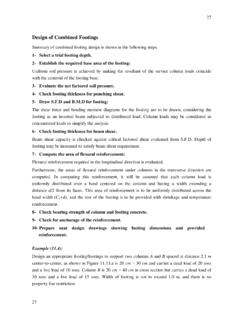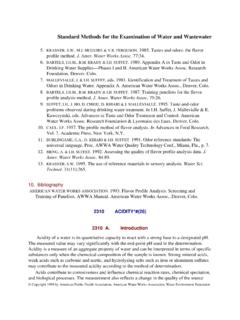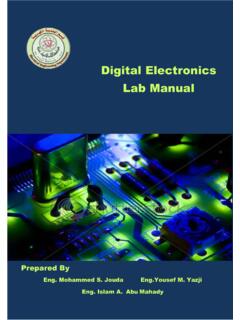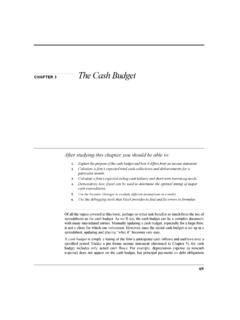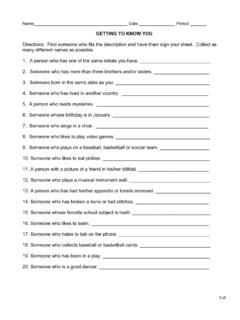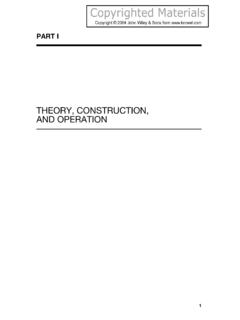Transcription of Modern Physics Third Edition RAYMOND A. SERWAY …
1 Modern Physics Third Edition RAYMOND A. SERWAY CLEMENT J. MOSES CURT A. MOYER 1 RELATIVITY Special Relativity The Principle of Relativity , The Speed of Light The Michelson Morley Experiment , Details of the Michelson Morley Experiment . Postulates of Special Relativity . Consequences of Special Relativity , Simultaneity and the Relativity of Time , Time Dilation Length Contraction . The Lorentz Transformation ,Lorentz Velocity Transformation SPECIAL RELATIVITY Classical mechanics Newton s laws: 1. Inertia: Any object moves with constant velocity as long as no net force acts upon it 2. Action: any object experiences acceleration in presence of a net force: F = ma : 3. Reaction If force F acts upon an object, F acts upon the object where the force originates. * To describe processes in nature one needs Reference Frame.
2 Reference Frame = Coordinate system to measure position + Clock to measure time. Inertial system: Reference frame where Newton s 1. law is applied. *Newtonian mechanics valid for object with velocity v<<c. (c: the speed of light) Light waves and other forms of electromagnetic radiation travel through free space at the speed c = x108 m/s. As we shall see in this chapter, the speed of light sets an upper limit for the speeds of particles, waves, and the transmission of information. Newtonian mechanics (Classical Mechanics) deals with objects that move at speeds much less than that of light, v<<c. Or objects in our every day life. Although Newtonian mechanics works very well at low speeds, it fails when applied to particles whose speeds approach that of light Experimentally, Physicists try to accelerate an electron through a large electric potential difference.
3 For example, it is possible to accelerate an electron to a speed of by using a potential difference of several million volts. According to Newtonian mechanics, if the potential difference (as well as the corresponding energy) is increased by a factor of 4, then the speed of the electron should be doubled to However, experiments show that the speed of the electron as well as the speeds of all other particles in the universe always remains less than the speed of light !!! *In 1905, at the age of 26, Albert Einstein published his special theory of relativity. Regarding the theory, Einstein wrote, (The relativity theory arose from necessity, from serious and deep contradictions in the old theory from which there seemed no escape. The strength of the new theory lies in the consistency and simplicity with which it solves all these difficulties, using only a few very convincing assumptions) The General Theory What is the general theory of relativity (Einstein 1915)?
4 It describes the relationships between gravity and the geometrical structure of space and time. Remarkable results include: light rays are affected by gravity, and the big bang theory (the universe is continually expanding) The general theory of relativity concerns with accelerating frames of reference Special theory of relativity, on the contrary, is only concerned with inertial frames of reference, that is, frames moving with constant velocities (no acceleration) postulates of special theory of relativity The laws of Physics are the same in all reference systems that move uniformly with respect to one another. That is, basic laws such as_ F = dp/dt have the same mathematical form for all observers moving at constant velocity with respect to one another. The speed of light in vacuum is always measured to be 3 x108 m/s, and the measured value is independent of the motion of the observer or of the motion of the source of light.
5 That is, the speed of light is the same for all observers moving at constant velocities. The Speed of light is a universal constant. THE PRINCIPLE OF RELATIVITY Recall from your studies in mechanics that Newton s laws are valid in inertial frames of reference. inertial frame: is one in which an object subjected to no forces moves in a straight line at constant speed thus the name inertial frame because an object observed from such a frame obeys Newton s first law, the law of inertia. Furthermore, any frame or system moving with constant velocity with respect to an inertial system must also be an inertial system. Thus there is no single, preferred inertial frame for applying Newton s laws According to the principle of Newtonian relativity, the laws of mechanics must be the same in all inertial frames of reference For example Galilean transformations The observer in the truck throws a ball straight up It appears to move in a vertical path The law of gravity and equations of motion under uniform acceleration are obeyed There is a stationary observer on the ground Views the path of the ball thrown to be a parabola The ball has a velocity to the right equal to the velocity of the truck The observer in the truck throws a ball straight up It appears to move in a vertical path The law of gravity and equations of motion under uniform acceleration are obeyed There is a stationary observer on the ground Views the path of the ball thrown to be a parabola , The ball has a velocity to the right equal to the velocity of the truck Indeed.
6 One of the firm philosophical principles of Modern science is that all observers are equivalent and that the laws of nature must take the same mathematical form for all observers. Laws of Physics that exhibit the same mathematical form for observers with different motions at different locations are said to be covariant. Definition of Event: An event is determined by the location where and by the time at which occurs, by (t, r) Two events are simultaneous if the time of the first event equals the time of the second event In Classical mechanics time is absolute, two simultaneous events will be simultaneous in any IRF. In order to show this let us make the following illustration: Consider two inertial systems or frames S and S', as in Figure The frame S' moves with a constant velocity v along the xx' axes, where v is measured relative to the frame S.
7 Clocks in S and S' are synchronized, and the origins of S and S' coincide at t = t'= 0. We assume that a point event, a physical phenomenon such as a lightbulb flash, occurs at the point P. An observer in the system S would describe the event with space time coordinates (x, y, z, t), whereas an observer in S would use (x', y', z', t') to describe the same event. As we can see from Figure , these coordinates are related by the equations These equations constitute what is known as a Galilean transformation of coordinates Note that the fourth coordinate, time, is assumed to be the same in both inertial frames. That is, in classical mechanics, all clocks run at the same rate regardless of their velocity, so that the time at which an event occurs for an observer in S is the same as the time for the same event in S'. Consequently, the time interval between two successive events should be the same for both observers.
8 Although this assumption may seem obvious, it turns out to be incorrect when treating situations in which v is comparable to the speed of light. In fact, this point represents one of the most profound differences between Newtonian concepts and the ideas contained in Einstein s theory of relativity Now suppose two events are separated by a distance dx and a time interval dt as measured by an observer in S. It follows from Equation that the corresponding displacement dx measured by an observer in S' is given by dx'= dx - v dt, where dx is the displacement measured by an observer in S. Because dt = dt ', we find that or where ux and u'x are the instantaneous velocities of the object relative to S and S', respectively. This result, which is called the Galilean addition law for velocities (or Galilean velocity transformation), is used in everyday observations and is consistent with our intuitive notions of time and space To obtain the relation between the accelerations measured by observers in S and S', we take a derivative of Equation with respect to time and use the results that dt = dt' and v is constant Galilean Space-Time Transformation ttzzyyvtxx ' ' ' 'Coordinates: Velocities: zzyyxxuuuuvuvdtdxdtdxu ''' -''Accelerations: zzyyxxaaaaadtxddtxda ''2222' ''Newton s Laws involving accelerations are invariant with respect to Galilean transformations!
9 EXAMPLE Assume that Newton s law Fx = max has been shown to hold by an observer in an inertial frame S. Show that Newton s law also holds for an observer in S' or is covariant under the Galilean transformation, that is, has the form F'x = m'a'x . Note that inertial mass is an invariant quantity in Newtonian dynamics. Solution : Starting with the established law Fx = max, we use the Galilean transformation a'x =ax and the fact that m' = m to obtain Fx = m'a'x . If we now assume that Fx depends only on the relative positions of m and the particles interacting with m, that is, Fx = f(x2 - x1, x3 - x1, ..), then Fx = F 'x , because the x s are invariant quantities. Thus we find F 'x = m'a'x and establish the covariance of Newton s second law in this simple case In Relativistic Mechanics time is relative * We will show that in Relativistic Mechanics time is relative, clocks record the passing of time differently in different inertial reference frames Example: consider a light signal emitted from A0 Event 1 =signal arrives A1 Event 2 =signal arrives A2 In IRF S events 1 and 2 are simultaneous if A0 is at rest an A0 A1 =A0 A2 , t1 =t2 In the IRF S which moves with v towards A0 evidently t 0 t 0 And the events are not simultaneous anymore.
10 O' S' v S A0 A1 A2 .. c c o The Speed of Light Maxwell in the 1860s showed that the speed of light in free space was given by *Physicists of the late 1800s were certain that light waves (like familiar sound and water waves) required a definite medium in which to move, called the ether *and that the speed of light was c only with respect to the ether or a frame fixed in the ether called the ether frame. In any other frame moving at speed v relative to the ether frame *the Galilean addition law was expected to hold. Thus, the speed of light in this other frame was expected to be c - v for light traveling in the same direction as the frame, c + v for light traveling opposite to the frame, and in between these two values for light moving in an arbitrary direction with respect to the moving frame If v is the velocity of the ether relative to the Earth, then the speed of light should have its maximum value, c + v, when propagating downwind, as shown in Figure Likewise, the speed of light should have its minimum value, c - v, when propagating upwind, as in Figure , and an intermediate value, (c 2 -v2)
